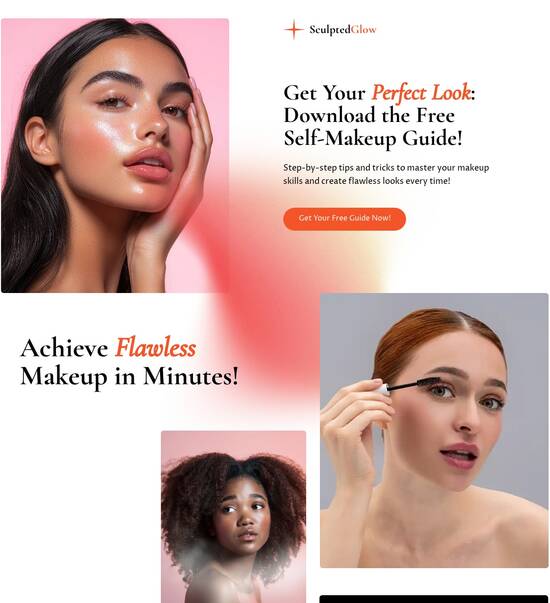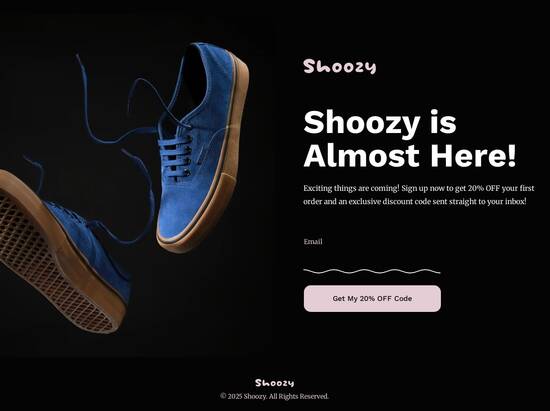
App page template for graphic design studios
Use TemplateAbout template
Engage your audience like never before with stunning landing page templates for graphic design studios. Make your online presence unforgettable!
Recommended templates

Easy to build without coding
With the intuitive drag-and-drop builder, anyone on your team can create high-converting pages without any knowledge of code or design. Make enhancements to your landing page with custom widgets using Javascript, HTML/CSS, or third-party scripts.

Multiple layouts for any industry and goal
Select from 500+ landing page layouts built to boost conversions across industry-specific scenarios. Customize them by adjusting fonts, adding images, and generating on-brand content with the AI assistant. Quickly scale with Instablocks® and Global Blocks that you can save, reuse, and update globally.

Loads fast and looks polished on any device
Every template is responsive, which means they present professionally on any device and load blazingly fast with our Thor Render Engine. You can also power them up with Google AMP technology to deliver an unparalleled mobile experience and drive higher conversions.

Robust analytics & experimentation
Get real-time updates and reporting across all your devices, showing the number of visitors, conversions, cost-per-visitor, and cost-per-lead. Launch AI-powered experiments, run A/B tests, and use heatmaps to analyze user behavior, then optimize your landing page to maximize conversions.







Easy to build without coding
With the intuitive drag-and-drop builder, anyone on your team can create high-converting pages without any knowledge of code or design. Make enhancements to your landing page with custom widgets using Javascript, HTML/CSS, or third-party scripts.
Multiple layouts for any industry and goal
Select from 500+ landing page layouts built to boost conversions across industry-specific scenarios. Customize them by adjusting fonts, adding images, and generating on-brand content with the AI assistant. Quickly scale with Instablocks® and Global Blocks that you can save, reuse, and update globally.
Loads fast and looks polished on any device
Every template is responsive, which means they present professionally on any device and load blazingly fast with our Thor Render Engine.
Robust analytics & experimentation
Get real-time updates and reporting across all your devices, showing the number of visitors, conversions, cost-per-visitor, and cost-per-lead. Launch AI-powered experiments, run A/B tests, and use heatmaps to analyze user behavior, then optimize your landing page to maximize conversions.
All the features you need to build lead-generating landing pages
Explore more featuresLearn how to build top-performing landing pages for any goal
FAQs
Leading the way in building high-performing landing pages





A step-by-step guide to optimizing landing pages with Instapage
Maximizing your digital marketing ROI starts with powerful landing pages that convert visitors into leads. With Instapage, marketers can create high-performing landing pages tailored to their audience, ensuring optimal engagement and conversions.
Understanding the Instapage platform
Instapage is not just a landing page builder; it’s a comprehensive conversion rate optimization platform. Whether you're in marketing or advertising, or part of a tech startup, understanding the tools you have at your disposal is crucial. Here are some key features that set Instapage apart:
- 100+ high-converting templates: Quickly launch campaigns without starting from scratch.
- Dynamic text replacement: Personalize your messaging for different audience segments.
- A/B testing capabilities: Experiment with different page versions to determine which resonates best with your visitors.
Building your first landing page on Instapage
Getting started with Instapage is simple. Here’s how to set up your landing page effectively:
- Choose a template: Select from a variety of customizable templates tailored for different industries.
- Use intuitive drag-and-drop editors: Instapage’s user-friendly interface allows for seamless edits and adjustments.
- Integrate lead generation elements: Embed forms and CTAs that encourage visitors to convert.
Optimizing for higher conversions
Once your landing page is live, optimization is key. Monitor performance and make adjustments as needed:
- Utilize heatmaps: Analyze visitor behavior to identify areas of confusion or drop-off.
- Conduct A/B tests: Regularly test different headlines, images, and layouts to see what works best.
- Leverage analytics: Use Instapage's dashboard to track key metrics such as conversion rates and traffic sources.
Following these initial steps can lead to significant improvements in your lead generation efforts.
In conclusion, mastering the Instapage platform will streamline your landing page creation and optimization process, allowing for measurable growth.
Ready to take your marketing campaigns to the next level? Sign up for Instapage today and unlock the full potential of your landing pages.
People also ask about App page template for graphic design studios
Understanding the essence of app page templates for graphic design studios
The role of app page templates in graphic design
App page templates serve as foundational tools that streamline the design process for graphic design studios. These templates offer a pre-constructed layout that can be customized to align with specific project requirements and client needs. Their significance extends beyond aesthetics; they are designed to maintain brand identity consistently across various platforms. As the world of graphic design continues to evolve, app page templates have been tailored to meet contemporary demands, taking into account the latest design trends and user behaviors.
The emergence of app page templates has completely transformed the landscape of graphic design websites. What once required extensive coding and development effort can now be accomplished in a matter of clicks. This evolution has prompted a surge in the availability of specialized templates that cater specifically to the needs of graphic design studios. As design requirements change, these templates continue to refine themselves, ensuring they remain relevant and highly functional.
Core functions of app page templates
One of the defining features of app page templates is their template flexibility. These templates are inherently adaptable, catering to diverse project types and client needs. They streamline the design workflow and empower designers to create visually stunning pages without needing extensive technical knowledge. Furthermore, a user-friendly interface for real-time editing allows designers to see immediate results, making it easier to adjust layouts and components as needed.
Additionally, modern app page templates seamlessly integrate with popular design tools and platforms. Compatibility with software such as Adobe, Sketch, and Figma simplifies the process of uploading assets and collaborating on design projects. These integrations often extend to other marketing tools, enhancing overall productivity and efficiency. In a world where speed and responsiveness are crucial, performance optimization features are built into many templates, ensuring they load quickly and perform well across devices.
User experience: navigating the app page template builder
User experience plays a pivotal role in the effectiveness of app page templates. Ensuring browser compatibility is essential for reaching a wider audience. Cross-browser support means that templates must function well across different web browsers like Chrome, Firefox, and Safari. Regular testing across various browsers helps identify and resolve any issues early in the design process, ensuring a smooth experience for end-users.
An intuitive interface design further enhances user experience by simplifying the navigation process. The implementation of drag-and-drop functionality is particularly effective in making the template builder accessible to both seasoned designers and novices alike. Comprehensive tutorials and support resources are invaluable, as they equip users with the knowledge needed to maximize the template's potential. Such resources instill confidence in users, encouraging them to experiment with layouts and design elements without fear of making mistakes.
Advanced design features that enhance creativity
Advanced design features found in app page templates play a significant role in fostering creativity. One of the most critical elements is color customization options, which allow designers to apply color theory effectively. Having access to tools for selecting and combining color palettes enables designers to establish brand consistency and evoke the desired emotions in their audience. This level of customization is essential for graphic design studios aiming to produce work that resonates strongly with their clients.
Moreover, website template builders often include capabilities for creating unique layouts. Designers can explore dynamic options that allow for versatile content display. Pre-made sections designed for showcasing portfolios, client testimonials, and contact forms give studios the flexibility they need to craft a comprehensive online presence. By leveraging these tools, designers can present their work in a way that captivates potential clients and highlights their unique service offerings.
Typography matters: fonts in app page templates
Typography is an essential component of graphic design, and app page templates typically come with extensive font libraries. Access to a wide range of font choices, including Google Fonts and custom fonts, allows designers to select typefaces that align with their brand's identity. Best practices for font pairing and hierarchy are crucial in creating visually appealing and readable text, helping convey the right message while ensuring clarity.
In addition to selection, font customization features play a key role in accessibility and readability. Designers can adjust weight, size, and style to ensure text remains legible across different devices. Utilizing web-safe fonts also ensures broader compatibility, reducing the risk of display issues. By focusing on typography, graphic design studios can enhance their websites, making them not only aesthetically pleasing but also user-friendly.
Structuring content: headings, columns, and layouts
Effective content structuring is vital in app page templates. Designing impactful headers involves crafting titles that succinctly communicate the essence of the content. Headers guide user navigation, making it clearer what section of the website users are engaging with. Strong headers can significantly improve user interaction by ensuring clarity and focus, essential in a design-centric field.
Moreover, employing columnar layouts aids in versatile content display. Best practices for using multi-column designs help enhance readability and allow for a balanced interplay between text and visuals. Implementing grids and appropriate spacing contributes to the aesthetic appeal; the significance of grid systems becomes apparent as they help align elements neatly, ensuring that content is engaging and easy to navigate. Utilizing margins and paddings thoughtfully allows for a clean and organized design.
Enriching designs with visual elements
Visual elements play a critical role in enriching app page templates. The incorporation of images and graphics must align with brand storytelling; best practices often include selecting images that resonate with the target audience. Tools for optimizing images for faster loading times are equally important, as they ensure a seamless user experience, preventing high bounce rates due to lagging visuals.
Furthermore, video integration is becoming a vital aspect of modern designs. Leveraging video content not only boosts engagement but also facilitates complex ideas' communication more effectively than static images. Guidelines for embedding videos from platforms like YouTube and Vimeo simplify the process, allowing graphic design studios to create dynamic and responsive content that captivates viewers and keeps them on the page longer.
Addressing common problems with app page templates
Despite their advantages, app page templates can encounter common problems. Performance issues often arise due to aspects like neglecting code optimization, leading to slow-loading pages. Addressing this requires a thorough analysis of the template’s code and efficiency. Critical strategies include minimizing image sizes, utilizing efficient scripts, and leveraging caching mechanisms to enhance loading speeds.
Additionally, ensuring design consistency across devices can pose challenges, particularly in responsive design. Testing strategies should be implemented to guarantee a uniform look across various screen sizes. Regular usability tests can identify discrepancies that may affect user experience, allowing designers to make necessary adjustments proactively. Finally, understanding user engagement challenges is crucial; analyzing feedback and behavior can inform design tweaks that lead to higher conversions.
Real-world applications and case studies
To better understand the real-world impact of app page templates, it’s useful to look at successful graphic design studios that have adopted these tools. Many top studios utilize app page templates effectively, significantly enhancing their efficiency. Case studies often illustrate not only improved workflow but also increased client satisfaction due to faster turnaround times and more polished presentations.
Feedback from designers also sheds light on the impact of app templates. Many industry professionals have shared insights on how these templates have transformed their operations, leading to creative breakthroughs and less time spent on repetitive tasks. Evaluating these success stories provides valuable metrics that reveal the intricacies of template utilization, highlighting the positive influence they have on the graphic design industry at large.
Future trends: evolving app page templates
Looking ahead, the incorporation of AI and automation technology into app page templates can greatly enhance customization capabilities. As designers increasingly seek to streamline processes, the automation of repetitive tasks is likely to become more prevalent. Predictions suggest that AI-driven tools will offer personalized suggestions based on user behavior and preferences, enabling designers to focus on strategic, high-level decisions rather than mundane adjustments.
Moreover, sustainability in design is gaining traction, and this trend will influence app page templates moving forward. Designers are becoming more eco-conscious, and templates that allow for sustainable design practices will likely gain popularity. Such features may include tools for assessing the environmental impact of design choices, helping studios promote eco-friendly principles while demonstrating their commitment to sustainability.
Enhancing template adoption: best practices
To maximize the benefits of app page templates, graphic designers should prioritize ongoing education and training. Online courses, webinars, and tutorials provide valuable resources for mastering template functionality. Staying updated with the latest trends and tools in the field fosters a culture of continuous improvement, ensuring designers remain competitive in a rapidly changing digital landscape.
In addition to individual education, engaging with community support can drive effective template adoption. Online forums, groups, and design communities create opportunities for collaboration and resource sharing among peers. These interactions often lead to insightful discussions, enabling designers to learn from each other’s experiences. By actively participating in these communities, designers can discover new ways to leverage app page templates for enhanced creativity and efficiency.
Ready to skyrocket conversions?
Supercharge your ad campaigns with high-performing landing pages
Get started














